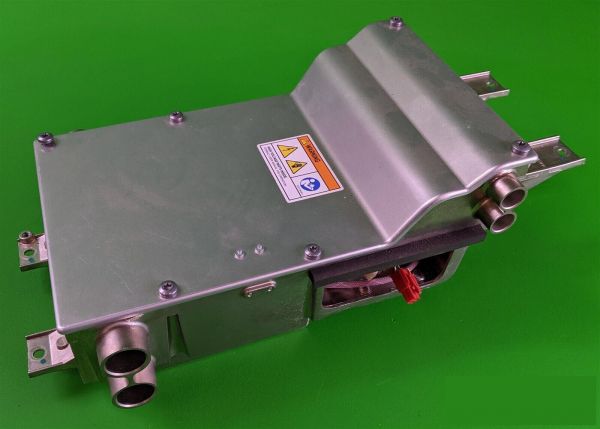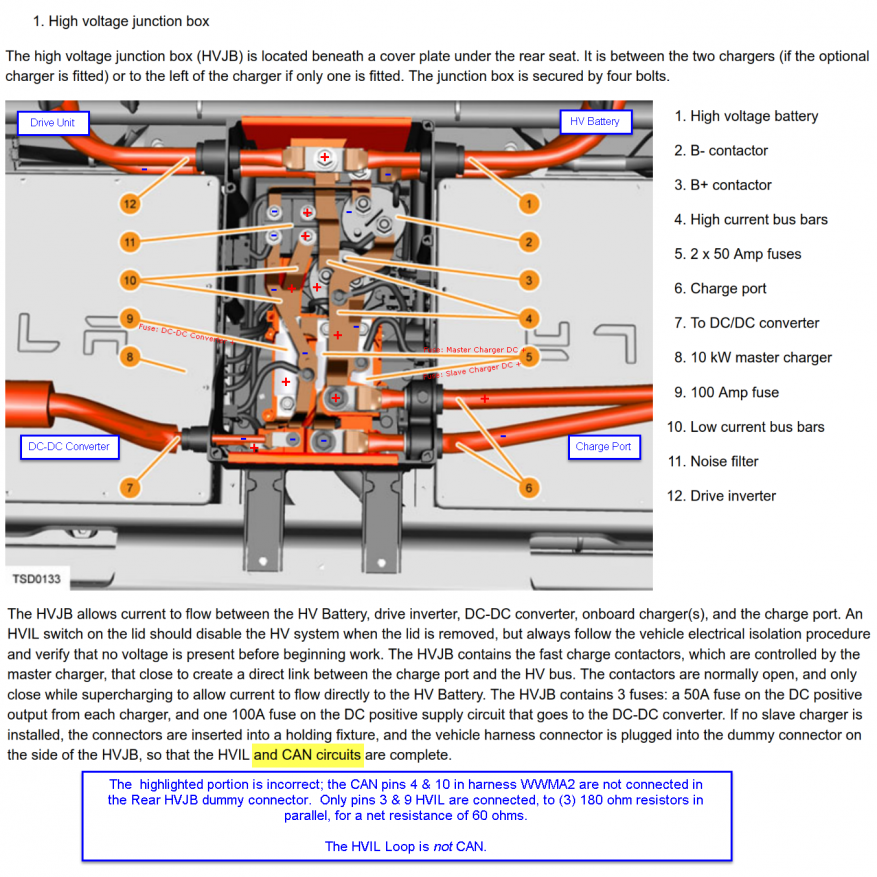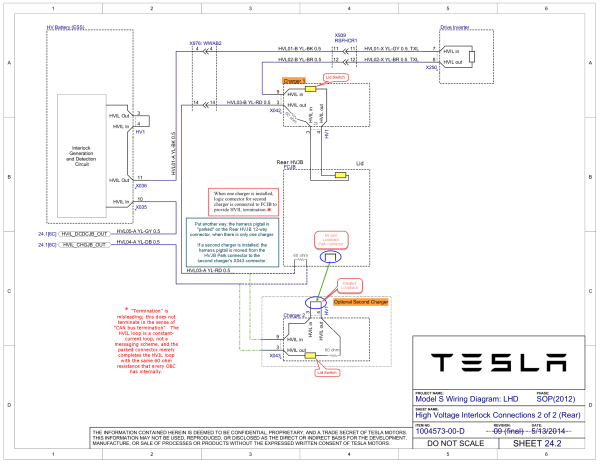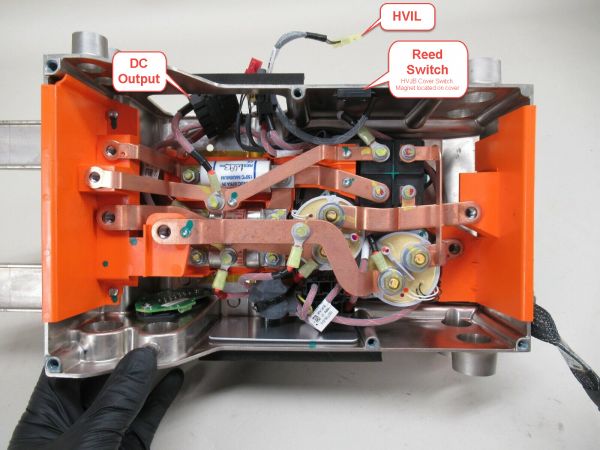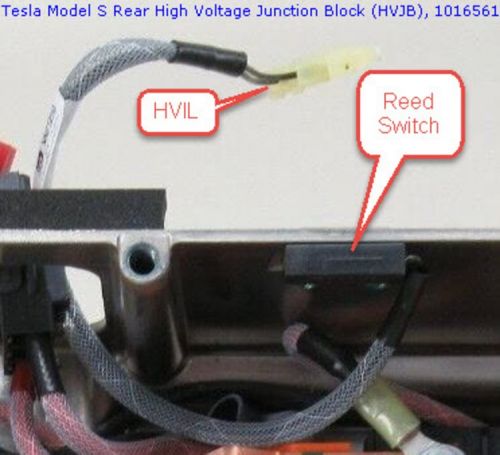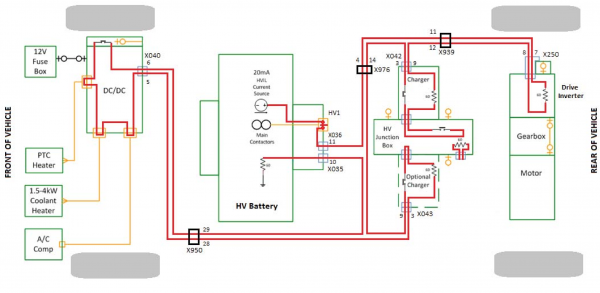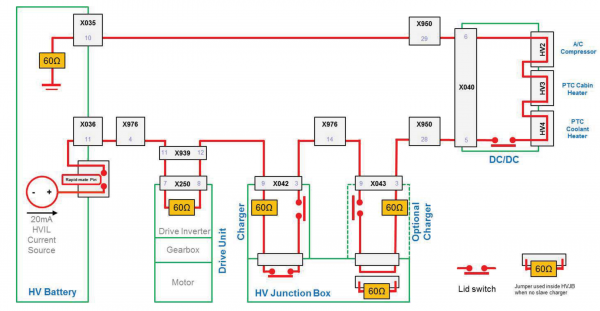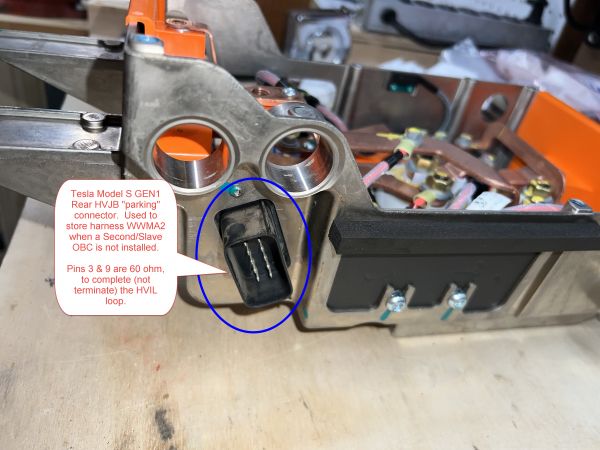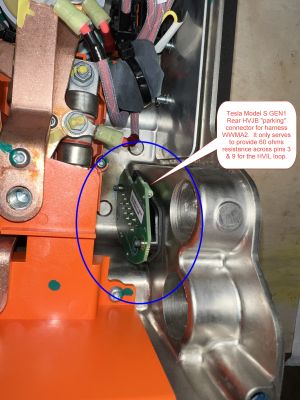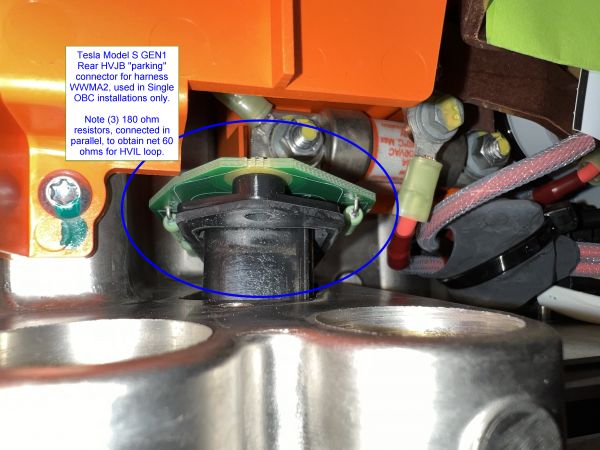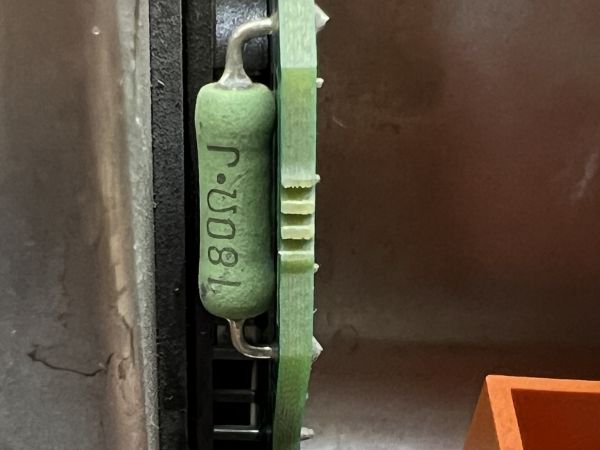Tesla Model S GEN1 Rear HVJB: Difference between revisions
| Line 7: | Line 7: | ||
* Traction Battery Pack (HV DC) | * Traction Battery Pack (HV DC) | ||
* Drive Unit ("Inverter") (rear only, as the Dual Motor option wasn't offered during the GEN1's | * Drive Unit ("Inverter") (rear only, as the Dual Motor option wasn't offered during the GEN1's lifespan) | ||
* Charge Port (AC and DC input) | * Charge Port (AC and DC input) | ||
* DC-DC Converter (GEN1, which also functioned as the ''Front'' HVJB) | * DC-DC Converter (GEN1, which also functioned as the ''Front'' HVJB) | ||
| Line 28: | Line 28: | ||
== HVIL == | == HVIL == | ||
The HVIL Loop | |||
[[File:2012 ModelS LHD Release 24.2-3b.png|alt=Telsa Model S GEN1 HVIL Schematic (amended).|thumb|600x600px|Telsa Model S GEN1 HVIL Schematic (amended): shows the lid switches explicitly called out, and the "parked" vs "installed" HVIL Loopback on Second/Slave OBC.|none]] | |||
These are used to integrate the HVJB's Lid Reed Switch into the HVIL loop. Every OBC contains a 60 ohm resistor in series with its Lid Switch (added to 2014 Wiring Diagram above, included by Tesla in Service Bulletin SB-10052449-4313 below, 2015), between Logic Connector (X042/X043) pin 3 and HVIL connector "top pin". | |||
*Tesla: Connected to the HVJB's Lid Reed Switch if the OBC is the only (single) or Master (dual) OBC. If the OBC is configured as Second/Slave, a loopback harness is connected instead. | |||
*Tesla: The loopback harness, Tesla 1101371-00-A, is included/stored inside all Tesla Model S GEN1 Rear HVJB in an internal "parking" socket, when only a single OBC is provisioned. | |||
The below two pictures show the GEN1 Rear HVJB's Lid Reed Switch, which had a relatively high failure rate<ref name=":1">https://static.nhtsa.gov/odi/tsbs/2014/SB-10052449-4313.pdf Pg. 10</ref> that caused shutdowns, error messages, and start failures:[[File:Tesla Model S Rear HVJB 05b.jpg|alt=Tesla Model S GEN1 HVJB (under rear seat), lid removed, showing the HVIL cover reed switch and HVIL connector that connects to a mating connector on the OBC.|thumb|600x600px|Tesla Model S GEN1 Rear HVJB (under rear seat), lid removed, showing the HVIL cover reed switch and HVIL connector that connects to a mating connector on the OBC.|left]][[File:Tesla Model S Rear HVJB 06b.jpg|alt=Closeup of Tesla Model S GEN1 HVJB (under rear seat), lid removed, showing the HVIL cover reed switch and HVIL connector that connects to a mating connector on the OBC.|500x500px|thumb|Tesla Model S GEN1 HVJB (under rear seat), lid removed, showing the HVIL cover reed switch and HVIL connector that connects to a mating connector on the OBC.|none]] | |||
The following two images showcase the "parking" connector on the Rear HVJB for harness WWMA2, which if not connected to a Second/Slave OBC, must be connected to this "parking" connector in order to obtain a 60 ohm resistor to complete the HVIL loop. The BMS maintains a constant current in the HVIL loop, and will not allow the contactors to close (or remain closed) if the correct resistance isn't measured in the HVIL loop<ref>https://static.nhtsa.gov/odi/tsbs/2014/SB-10052449-4313.pdf Pg. 1</ref>. Telsa's various documentation from this era have several inaccuracies when verified against actual vehicles; do not rely upon documented pinouts.[[File:SB-10052449-4313 HVIL Diagnostic Guide 01-1b.png|alt=Tesla Model S GEN1 HVIL circuit overview, from Tesla Service Bulletin SB-10052449-4313, pg. 1.|left|thumb|600x600px|Tesla Model S GEN1 HVIL circuit overview, from Tesla Service Bulletin SB-10052449-4313, pg. 1.]][[File:SB-10052449-4313 HVIL Diagnostic Guide 08-1b.png|alt=Tesla Model S GEN1 HVIL circuit overview, from Tesla Service Bulletin SB-10052449-4313, pg. 7.|center|thumb|600x600px|Tesla Model S GEN1 HVIL circuit overview, from Tesla Service Bulletin SB-10052449-4313, pg. 8.]] | |||
[[File:Tesla Model S Rear HVJB 16b.jpg|alt=Telsa Model S GEN1 Rear HVJB: harness WWMA2 "parking" connector which contains only a 60 ohm resistor. This connector is used when a Tesla does not have a Second/Slave OBC.|thumb|600x600px|Telsa Model S GEN1 Rear HVJB: front view of harness WWMA2 "parking" connector which contains only a 60 ohm resistor. This connector is used when a Tesla does not have a Second/Slave OBC.|left]][[File:Tesla Model S Rear HVJB 15b.jpg|alt=Telsa Model S GEN1 Rear HVJB: rear views of harness WWMA2 "parking" connector which contains only a 60 ohm resistor. This connector is used when a Tesla does not have a Second/Slave OBC.|none|thumb|Telsa Model S GEN1 Rear HVJB: rear view of harness WWMA2 "parking" connector which contains only a 60 ohm net resistance. This connector is used when a Tesla does not have a Second/Slave OBC.]][[File:Tesla Model S Rear HVJB 20b.jpg|alt=Tesla Model S GEN1 Rear HVJB "parking" connector for harness WWMA2, used in Single OBC installations only. Note (3) 180 ohm resistors, connected in parallel, to obtain net 60 ohms for HVIL loop.|thumb|600x600px|Tesla Model S GEN1 Rear HVJB "parking" connector for harness WWMA2, used in Single OBC installations only. Note (3) 180 ohm resistors, connected in parallel, to obtain net 60 ohms for HVIL loop.|left]][[File:Tesla Model S Rear HVJB 14b.jpg|none|thumb|600x600px|alt=180 ohm resistor. One of three on the Tesla Model S GEN1 Rear HVJB "parking" connector for harness WWMA2, which is used only in Single OBC installations. |180 ohm resistor. One of three on the Tesla Model S GEN1 Rear HVJB "parking" connector for harness WWMA2, which is used only in Single OBC installations.]] | |||
Revision as of 02:02, 24 March 2023
Overview
The Tesla Model S GEN1 Rear HVJB was a High Voltage Junction Box found in the all 2012 through late 2013 Model S. It is centrally located under the rear seat frame, and the Single or Dual GEN1 On-board Charger(s) (OBC) are located to the right and left of it. It was replaced via gradual phase-in by the GEN2 Rear HVJB starting around Oct2013, when the GEN2 On-board Chargers were introduced; the GEN1 & GEN2 Rear HVJBs are not interchangeable, physically nor electrically.
It functions as a junction for connections to these subsystems:
- Traction Battery Pack (HV DC)
- Drive Unit ("Inverter") (rear only, as the Dual Motor option wasn't offered during the GEN1's lifespan)
- Charge Port (AC and DC input)
- DC-DC Converter (GEN1, which also functioned as the Front HVJB)
- On-Board Charger(s) (GEN1 Chargers only)
Connections
HV
All HV connections are well documented by the "Theory of Operation" image below. All are bolted connections.
LV
Depending upon whether Single or Dual OBCs are installed, either (1), or (5), of the LV connectors will not be in use. Extra/unused internal harnessed connectors have "parking" places to stow unused connectors. The various LV connectors are detailed below.
Logic "dummy" connector
This is a panel-mount Molex MX150L Panel-Mount PCB 19428-0001 plug. It has a small PCB soldered to its rear, which contains ONLY (3) 180 ohm resistors, wired in parallel, to provide a net 60 ohm path for the HVIL Loop, on pins 3 & 9. See HVIL section for details on how this connector is used.
HVIL
The HVIL Loop
These are used to integrate the HVJB's Lid Reed Switch into the HVIL loop. Every OBC contains a 60 ohm resistor in series with its Lid Switch (added to 2014 Wiring Diagram above, included by Tesla in Service Bulletin SB-10052449-4313 below, 2015), between Logic Connector (X042/X043) pin 3 and HVIL connector "top pin".
- Tesla: Connected to the HVJB's Lid Reed Switch if the OBC is the only (single) or Master (dual) OBC. If the OBC is configured as Second/Slave, a loopback harness is connected instead.
- Tesla: The loopback harness, Tesla 1101371-00-A, is included/stored inside all Tesla Model S GEN1 Rear HVJB in an internal "parking" socket, when only a single OBC is provisioned.
The below two pictures show the GEN1 Rear HVJB's Lid Reed Switch, which had a relatively high failure rate[1] that caused shutdowns, error messages, and start failures:
The following two images showcase the "parking" connector on the Rear HVJB for harness WWMA2, which if not connected to a Second/Slave OBC, must be connected to this "parking" connector in order to obtain a 60 ohm resistor to complete the HVIL loop. The BMS maintains a constant current in the HVIL loop, and will not allow the contactors to close (or remain closed) if the correct resistance isn't measured in the HVIL loop[2]. Telsa's various documentation from this era have several inaccuracies when verified against actual vehicles; do not rely upon documented pinouts.
Errata
GEN1 Rear HVJB Dimensions:
- Weight: nn lbs (nn kg)
Tesla Part Numbers (TPN):
- 1016561
